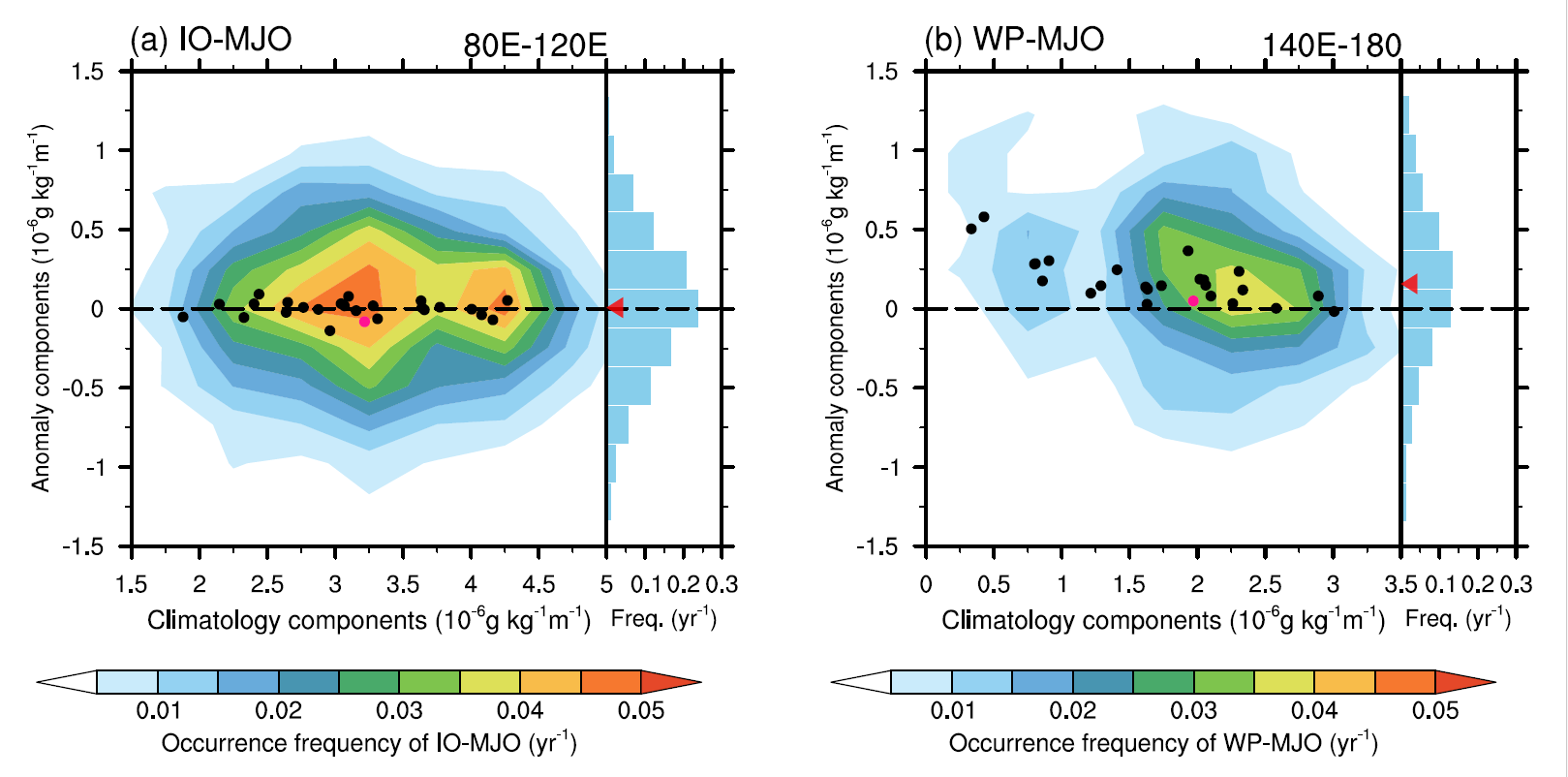中国科学院大气物理研究所大气科学和地球流体力学数值模拟国家重点实验室
State Key Laboratory of Numerical Modeling for Atmospheric Sciences and
Geophysical Fluid Dynamics (LASG)
Institute of Atmospheric Physics, Chinese Academy of Sciences
State Key Laboratory of Numerical Modeling for Atmospheric Sciences and
Geophysical Fluid Dynamics (LASG)
Institute of Atmospheric Physics, Chinese Academy of Sciences

Vol.17/No.17 April 2022
Tracking the MJO Precipitation: from CMIP5 to CMIP6
Most previous studies focus on the impacts of climatology biases on MJO simulation. Researchers from the Institute of Atmospheric Physics at Chinese Academy of Sciences have recently explored the processes affecting the simulations of the MJO propagation by identifying individual MJO events through tracking their precipitation in climate model simulations.
To quantified how well the current climate models can simulate the MJO, the study applied the Coupled Model Intercomparison Project Phase 6 (CMIP6) and Phase 6 (CMIP5), and investigated their MJO simulation skills.
Researchers diagnosed 17 pairs of CMIP5 and CMIP6 simulations, and found that CMIP6 models still underestimate the MJO propagation characteristics comparing to the observations. One improvement is that the inter-model spreads of MJO propagation characteristics are obviously reduced from CMIP5 to CMIP6. Models that struggle more in simulating the MJO in their CMIP5 versions show more obvious improvements in simulating the MJO. For the top six pairs of models that show most obvious improvements from CMIP5 to CMIP6, the MJO simulation improvements are mainly reflected by the increased possibility of the MJO propagating through the Maritime Continent. “The possible reason is that the enhanced land precipitation before the MJO enter the Maritime Continent is better reproduced in CMIP6”. Explained Dr. CHEN Guiwan, the lead author of the study published in Geophysical Research Letters.

Figure 1. Spider plots for the magnitudes of the MJO characteristics in (a) 17 pairs of CMIP5 and CMIP6 simulations and (b) top six simulations with most distinct MJO simulation improvements from CMIP5 to CMIP6 relative to TRMM observations.(Image by CHEN Guiwan)
The team further studied roles of background states in low-level moisture on MJO simulation over the Indian Ocean and western Pacific in climate models. The background states of the MJO were decomposed into the climatology and anomaly components in this study. It was found that the occurrence frequency of MJO events over the Indian Ocean is mainly determined by the climatology component, while the occurrence frequency of MJO events over the western Pacific is also regulated by the year-to-year variabilities of the background states.

Figure 2. Joint distributions of (a) IO-MJO and (b) WP-MJO events occurrence frequencies as functions of their anomaly components and climatology components the background meridional gradient of low-level moisture ahead of the MJO convection center in the simulations.(Image by CHEN Guiwan)
“To better reproduce the MJO propagation, we therefore suggest models need to accurately simulate the interannual variabilities, and land-sea precipitation evolutions over the Maritime Continent.” Prof. LIN Jian, the corresponding author added.
References:
1. Chen Guiwan, Ling Jian*, Zhang Rongwang, Xiao Ziniu and Li Chongyin. 2022. The MJO from CMIP5 to CMIP6: Perspectives from tracking MJO precipitation. Geophysical Research Letters, 49, e2021GL095241. https://doi. org/10.1029/2021GL095241
Link:https://agupubs.onlinelibrary.wiley.com/doi/10.1029/2021GL095241
2. Chen Guiwan, Ling Jian*, Zhang Yuanwen, Wang Xin and Li Chongyin. 2022. MJO Propagation over the Indian Ocean and Western Pacific in CMIP5 Models: Roles of Background States, Journal of Climate, 35(3), 955-973. https://doi.org/10.1175/JCLI-D-21-0255.1
Link:https://journals.ametsoc.org/view/journals/clim/35/3/JCLI-D-21-0255.1.xml
3. Chen Guiwan, Chen S. Shuyi, Ling Jian* and Li Chongyin. 2021. Large-scale precipitation systems: Essential elements of the Madden-Julian Oscillation. Geophysical Research Letters, 48, e2021GL093184. https://doi.org/10.1029/2021GL093184
Link:https://agupubs.onlinelibrary.wiley.com/doi/10.1029/2021GL093184
Contact: LING Jian, lingjian@lasg.iap.ac.cn
Add: No.40, Huayanli, Beichen West Road, Chaoyang District, Beijing P.O. Box 9804, 100029, China
E-mail: lasg_newsletter@lasg.iap.ac.cn
Editors: Chuanyi Wang (wangcy@lasg.iap.ac.cn), Kangjun Chen(ckj@lasg.iap.ac.cn)
E-mail: lasg_newsletter@lasg.iap.ac.cn
Editors: Chuanyi Wang (wangcy@lasg.iap.ac.cn), Kangjun Chen(ckj@lasg.iap.ac.cn)